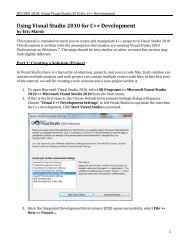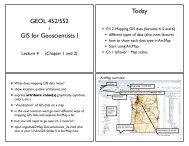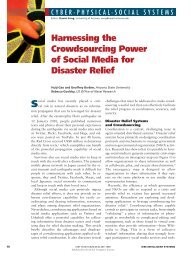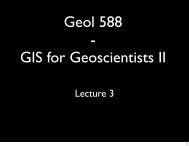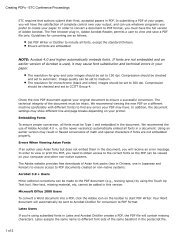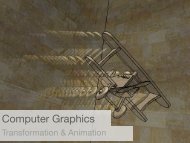color n-ary gray code for 3-d shape measurement - Iowa State ...
color n-ary gray code for 3-d shape measurement - Iowa State ...
color n-ary gray code for 3-d shape measurement - Iowa State ...
You also want an ePaper? Increase the reach of your titles
YUMPU automatically turns print PDFs into web optimized ePapers that Google loves.
ICEM12- 12th International Conference on Experimental Mechanics<br />
29 August - 2 September, 2004 Politecnico di Bari, Italy<br />
COLOR N-ARY GRAY CODE FOR 3-D SHAPE MEASUREMENT<br />
Jiahui Pan, Peisen S. Huang, Song Zhang, Fu-Pen Chiang<br />
Department of Mechanical Engineering, Stony Brook University, Stony Brook, 11794, NY,<br />
USA, Jiahui_new@yahoo.com or Peisen.huang@sunysb.edu<br />
ABSTRACT<br />
A fringe projection method that uses a novel <strong>color</strong> N-<strong>ary</strong> Gray <strong>code</strong> has been developed <strong>for</strong> high-speed 3-D<br />
<strong>shape</strong> <strong>measurement</strong>. In this method, more than two <strong>gray</strong>levels in each <strong>color</strong> channel are used to create a <strong>color</strong><strong>code</strong>d<br />
pattern. The <strong>code</strong> is designed to be self-normalizing so that an adaptive threshold method can be used to<br />
reduce decoding error and there<strong>for</strong>e increase <strong>measurement</strong> resolution and accuracy. Two example N-<strong>ary</strong> <strong>code</strong>s, a<br />
tern<strong>ary</strong> <strong>code</strong> (N = 3) and a sextan<strong>ary</strong> <strong>code</strong> (N = 6), were examined. Their effectiveness was tested in two systems,<br />
one consisting of a LCD projector and a <strong>color</strong> 3-CCD camera while the other, a high-speed fringe projection<br />
system, consisting of a DLP projector and a black-and-white CCD camera. In the latter system, the <strong>color</strong> pattern<br />
is projected in <strong>gray</strong> scale, one <strong>color</strong> channel at a time and at a high switching speed (80 Hz). There<strong>for</strong>e, it is less<br />
sensitive to the imbalance problem of the three <strong>color</strong> channels and the <strong>measurement</strong> result is also not affected by<br />
the surface <strong>color</strong> of the object. The feasibility and effectiveness of the two coding methods were confirmed by<br />
experiments. The results showed that the tern<strong>ary</strong> coding method produced better and more reliable <strong>measurement</strong><br />
results than the sextan<strong>ary</strong> coding method. The proposed technique has various potential applications in highspeed<br />
3-D <strong>shape</strong> <strong>measurement</strong>s, especially in on-line inspection or dynamic <strong>measurement</strong> of moving objects.<br />
1. INTRODUCTION<br />
Fringe projection techniques are being widely used today <strong>for</strong> 3-D <strong>shape</strong> <strong>measurement</strong> because<br />
of the ubiquitous availability of video projectors. One frequently used such technique is the<br />
bin<strong>ary</strong> fringe projection technique, which has the merits of being significantly less sensitive to<br />
system noise and nonlinearity error [1, 2]. However, one drawback of this technique is that it<br />
usually requires several fringe patterns <strong>for</strong> measuring the 3-D <strong>shape</strong> of an object, which<br />
reduces the <strong>measurement</strong> speed. As a result, this technique is not suitable <strong>for</strong> dynamic or realtime<br />
<strong>measurement</strong>s. To reduce the number of required fringe patterns, some techniques that<br />
use more intensity levels to <strong>code</strong> the patterns have been proposed [3]. In these techniques, a<br />
new concept, N-<strong>ary</strong> <strong>code</strong>, which is a generalization of bin<strong>ary</strong> <strong>code</strong>, was introduced. In the N-<br />
<strong>ary</strong> <strong>code</strong>, N intensity levels are used <strong>for</strong> coding. Bin<strong>ary</strong> <strong>code</strong> is then just a special case of N-<br />
<strong>ary</strong> <strong>code</strong> when N equals to 2. Caspi et al. developed a <strong>color</strong> N-<strong>ary</strong> Gray <strong>code</strong> <strong>for</strong> range sensing<br />
in which the number of fringe patterns M and the number of intensity levels N i in each<br />
individual <strong>color</strong> channel are automatically adapted to the environment [4]. Horn and Kiryati<br />
provided an optimal design <strong>for</strong> generating the N-<strong>ary</strong> <strong>code</strong> with the smallest set of projection<br />
patterns that meets the application-specific accuracy requirements given the noise level in the<br />
system [5]. The above two techniques significantly reduced the number of fringe patterns by<br />
adopting N-<strong>ary</strong> <strong>code</strong>s. However, they required one or two additional uni<strong>for</strong>m illumination<br />
references to generate the individual threshold <strong>for</strong> each pixel to achieve high resolution.<br />
In this paper, we develop a technique that requires only a single fringe projection <strong>for</strong> highspeed<br />
3-D <strong>shape</strong> <strong>measurement</strong>. A novel <strong>color</strong> N-<strong>ary</strong> Gray <strong>code</strong> is designed <strong>for</strong> this purpose.
Object<br />
CCD<br />
Camera<br />
Digital<br />
Projector<br />
Fig. 1 Layout of the 3-D <strong>shape</strong> <strong>measurement</strong> system<br />
The threshold <strong>for</strong> binarization at each pixel can be obtained from the <strong>code</strong>d pattern itself<br />
without additional uni<strong>for</strong>m illumination references. The coding and decoding schemes, system<br />
setup and implementation, and experimental results are presented.<br />
2. SYSTEM SETUP<br />
The system layout of the fringe projection technique that uses the proposed <strong>color</strong> N-<strong>ary</strong> Gray<br />
<strong>code</strong> is shown in Fig. 1. This system consists of an LCD projector (EPSON PowerLite 8000i;<br />
2000 ANSI lumens; 1024 × 768 resolution), a 3-CCD <strong>color</strong> camera (Duncantech MS2100;<br />
656 × 494 resolution), a frame grabber (Matrox Corona), and a PC (Pentium III 866 MHz). A<br />
<strong>color</strong> fringe pattern is created by software in the computer and projected onto the object by the<br />
projector connected to the computer. The fringe image of the object is captured by the camera<br />
positioned at a certain angle with respect to the projector. The captured image is then digitized<br />
and the intensity in each <strong>color</strong> channel of each pixel is determined. Finally, each pixel is<br />
de<strong>code</strong>d and the corresponding height in<strong>for</strong>mation of the object at the pixel is calculated<br />
based on a triangulation algorithm [1].<br />
3. CODING<br />
A <strong>code</strong> is composed of many <strong>code</strong>words, which are unambiguous identifiers <strong>for</strong> the<br />
combination of a set of <strong>code</strong> digits. Proper design of the <strong>code</strong> or the combination of the<br />
<strong>code</strong>words is critical <strong>for</strong> the <strong>measurement</strong> system to achieve higher resolution and accuracy.<br />
3.1 N-<strong>ary</strong> Gray Code<br />
To reduce decoding errors and increase the margin of noise, a Gray <strong>code</strong> scheme is employed<br />
in coding the pattern. Gray <strong>code</strong> is originally used in the areas of telecommunication and<br />
circuit design and has been widely used <strong>for</strong> pattern coding recently. In a Gray <strong>code</strong>, the<br />
number of different <strong>code</strong> digits between any two adjacent <strong>code</strong>words, called Hammingdistance,<br />
is one. Due to this feature, those pixels with mixed <strong>color</strong>s will be determined to have<br />
either one of the two participant <strong>color</strong>s rather than a third <strong>color</strong>. There<strong>for</strong>e the decoding error<br />
due to mixed <strong>color</strong>s can be minimized to just 1 pixel, which results in higher spatial
esolution. In an N-<strong>ary</strong> Gray <strong>code</strong>, each digit may have any value ranging from 0 to N-1 based<br />
on radix of N. The number of available <strong>code</strong>words is N M if M fringe patterns are used.<br />
There are many ways to generate the N-<strong>ary</strong> Gray <strong>code</strong>. Table 1 shows the two typical number<br />
systems representing such a <strong>code</strong> as well as their corresponding decimal and triple expressions<br />
<strong>for</strong> a 3-digit number system. The first system is a cyclic number system. By cyclic, we mean<br />
that the Gray <strong>code</strong> is circular. In other words, the first <strong>code</strong>word is the successor of the last<br />
<strong>code</strong>word. There<strong>for</strong>e, the cyclic number system produces a circular Gray <strong>code</strong> that can be<br />
repeatedly used in order to increase the length of the <strong>code</strong> [6, 7]. However, one drawback of<br />
the cyclic number system is that the value of the changing digit can differ by more than one<br />
between the neighbouring <strong>code</strong>words. This will significantly increase the ambiguity of<br />
decoding. Another system, a reflected number system, uses a different approach to organize<br />
the number so that the value of the changing digit will only change one from one <strong>code</strong>word to<br />
another. In the reflected number system, the value of each digit changes from 0 to N - 1 first<br />
and then from N - 1 back to 0 as if reflected from a mirror [8, 9]. By organizing the <strong>code</strong> as a<br />
reflected number system, the difference between any adjacent <strong>code</strong>words will be minimized.<br />
However, the reflected number system can not always produce a circular Gray <strong>code</strong>. Only<br />
when N is even can the <strong>code</strong> be a circular Gray <strong>code</strong>. In this paper, we propose a coding<br />
scheme that has the advantages of both the cyclic and the reflected systems, which will be<br />
introduced in the next sub-section.<br />
3.2 Color N-<strong>ary</strong> Gray Code<br />
In this sub-section, we describe a <strong>color</strong> N-<strong>ary</strong> Gray <strong>code</strong> that has both the advantages of the<br />
cyclic and reflected systems as well as some other features that can benefit our application.<br />
The purpose of designing this <strong>code</strong> is to be able to measure the 3-D <strong>shape</strong> of an object with a<br />
single fringe pattern, so that dynamic or real-time <strong>measurement</strong> can be achieved. To design<br />
such a <strong>code</strong>, the following strategies need to be used:<br />
• To obtain more <strong>code</strong>words with one fringe pattern, all the three <strong>color</strong> channels should be<br />
used. There<strong>for</strong>e, the number of fringe patterns M can be regarded as three.<br />
• Because of the limited number of unique <strong>code</strong>words, the available <strong>code</strong>words need to be<br />
used periodically. There<strong>for</strong>e, the <strong>code</strong> should be cyclic.<br />
• To reduce decoding errors, the values of the changing digit should only differ by one<br />
between any adjacent <strong>code</strong>words, which means that the <strong>code</strong> should be reflected<br />
• To make the system more tolerable to nonuni<strong>for</strong>m illumination and surface reflectivity, a<br />
self-normalizing scheme should be used in coding [2]. This requires at least one digit with<br />
the maximum value of N - 1 and another with the minimum value of 0 in any <strong>code</strong>word.<br />
Once so <strong>code</strong>d, each pixel will have its own maximum and minimum intensity values<br />
appearing at least once. As a result, an appropriate threshold value can be set <strong>for</strong> each<br />
pixel <strong>for</strong> digitization. This is called the adaptive threshold method.<br />
It can be proven that the number of unique <strong>code</strong>words <strong>for</strong> the proposed <strong>color</strong> N-<strong>ary</strong> Gray <strong>code</strong><br />
is 6 × (N - 1). Table 2 shows two examples of the <strong>color</strong> N-<strong>ary</strong> Gray <strong>code</strong> when N = 3 and N =<br />
6, which are called tern<strong>ary</strong> <strong>code</strong> and sextan<strong>ary</strong> <strong>code</strong> respectively. The number of available<br />
<strong>code</strong>words are 6 × (3 - 1) = 12 and 6 × (6 - 1) = 30 respectively. The <strong>for</strong>mation of the <strong>color</strong><br />
N-<strong>ary</strong> Gray <strong>code</strong>s is illustrated in Fig. 2. It can be seen that to satisfy all the requirements<br />
listed above, the three <strong>color</strong> channels are <strong>code</strong>d to have T/3 shifts between each other, where T<br />
is the length of the <strong>code</strong> using all the available unique <strong>code</strong>words. The larger the value of N is,
the larger the value of T will be. With a larger T value, there will be more unique <strong>code</strong>words<br />
available, which makes the system more tolerable to the discontinuity problem. An extreme<br />
extension of the <strong>color</strong> N-<strong>ary</strong> Gray <strong>code</strong> is shown in Fig. 2(c) with N being 256 in an 8-bit<br />
system. This is the so called intensity ratio method which provides higher resolution compared<br />
to our proposed method. However, the intensity ratio method is highly sensitive to system<br />
noise and projector nonlinearity. In this work, the tern<strong>ary</strong> and sextan<strong>ary</strong> <strong>code</strong>s, which are used<br />
periodically <strong>for</strong> improved resolution, are tested to demonstrate the feasibility of the proposed<br />
technique.<br />
Table 1 A comparison of different<br />
number systems<br />
Table 2 Codewords of the <strong>color</strong> N-<strong>ary</strong><br />
Gray <strong>code</strong>s<br />
Decimal Triple<br />
N-<strong>ary</strong> Gray Code<br />
Cyclic Triple Reflected Triple<br />
0 000 000 000<br />
1 001 001 001<br />
2 002 002 002<br />
3 010 012 012<br />
4 011 010 011<br />
5 012 011 010<br />
6 020 021 020<br />
7 021 022 021<br />
8 022 020 022<br />
9 100 120 122<br />
10 101 121 121<br />
11 102 122 120<br />
12 110 102 110<br />
13 111 100 111<br />
14 112 101 112<br />
15 120 111 102<br />
16 121 112 101<br />
17 122 110 100<br />
18 200 210 200<br />
19 201 211 201<br />
20 202 212 202<br />
21 210 222 212<br />
22 211 220 211<br />
23 212 221 210<br />
24 220 201 220<br />
25 221 202 221<br />
26 222 200 222<br />
No.<br />
Tern<strong>ary</strong> Sextan<strong>ary</strong><br />
RGB RGB<br />
0 020 050<br />
1 021 051<br />
2 022 052<br />
3 012 053<br />
4 002 054<br />
5 102 055<br />
6 202 045<br />
7 201 035<br />
8 200 025<br />
9 210 015<br />
10 220 005<br />
11 120 105<br />
12 205<br />
13 305<br />
14 405<br />
15 505<br />
16 504<br />
17 503<br />
18 502<br />
19 501<br />
20 500<br />
21 510<br />
22 520<br />
23 530<br />
24 540<br />
25 550<br />
26 450<br />
27 350<br />
28 250<br />
29 150<br />
4. DECODING<br />
The decoding procedure includes calculating the <strong>code</strong>word value <strong>for</strong> each pixel and<br />
generating a continuous <strong>code</strong>word map. These two steps are very similar to the phase<br />
wrapping and unwrapping procedures used in the phase shifting methods [10].<br />
In the first step, the intensity value of each pixel is digitized into N different levels according<br />
to the maximum and minimum intensity values at the pixel. The <strong>code</strong>word value of each pixel<br />
is then obtained based on the digitized values. Since the <strong>code</strong>words are defined periodically<br />
along the decoding direction, they appear like a sawtooth <strong>shape</strong> and discontinuities occur<br />
periodically.
0<br />
1<br />
2<br />
blue<br />
green<br />
red<br />
(a) Tern<strong>ary</strong> <strong>code</strong><br />
blue<br />
green<br />
red<br />
0 1 3 4 5 (b) Sextan<strong>ary</strong> <strong>code</strong><br />
255<br />
0<br />
green<br />
blue<br />
red<br />
(c) An extreme extension: trapezoidal <strong>code</strong><br />
Fig. 2. The <strong>color</strong> N-<strong>ary</strong> Gray Codes<br />
To generate a continuous <strong>code</strong>word map, the discontinuities need to be removed in the second<br />
step. Since the <strong>code</strong>words are not unique along the decoding direction, any holes or bad points<br />
on the image can prevent decoding from tracing back the previous <strong>code</strong>word. There<strong>for</strong>e,<br />
decoding of one row can not be done without taking into account its adjacent rows. In this<br />
work, we developed an iterative algorithm to reconstruct the continuous <strong>code</strong>word map. With<br />
this algorithm, the value of each <strong>code</strong>word is retrieved according to its own calculated value<br />
together with the value of the pixel in the previous row or previous column along the<br />
decoding direction. If the variation of the <strong>code</strong>word values between neighboring pixels is<br />
greater than 6 × (N - 1) / 2, the value of the <strong>code</strong>word should be increased or decreased by<br />
6 × (N - 1) depending on whether the variation is negative or positive.<br />
5. EXPERIMENTS<br />
A flat board with a smooth surface was measured to verify the uncertainty of the <strong>measurement</strong><br />
system. The measured area was 220 × 165 mm. Both the tern<strong>ary</strong> and sextan<strong>ary</strong> coding<br />
methods were used. The cross sections of the 300th row of the 3-D results are shown in Fig. 3.<br />
The noise of the tern<strong>ary</strong> coding method is RMS 0.1 mm while the noise of the sextan<strong>ary</strong><br />
coding method is much larger. This is because the more <strong>gray</strong>levels used <strong>for</strong> coding, the more<br />
decoding errors will be introduced due to image noise.<br />
A more complex object, a plaster head, was also measured with both of the two coding<br />
methods. Since the <strong>code</strong> is self-normalizing, the texture of the object could be extracted from<br />
the maximum intensity of each pixel. The 3-D results with and without texture mapping<br />
reconstructed by the tern<strong>ary</strong> coding method are shown in Fig. 4. The result of the sextan<strong>ary</strong><br />
coding method showed much larger decoding errors and is not shown here.<br />
From the experimental results, it can be seen that some stripes appear on the reconstructed<br />
surface of the object. It is even clearer on the surface with texture mapping. These errors were<br />
caused by the imbalance of the three channels. Since the texture image is acquired by<br />
extracting the maximum value of the three channels, the imbalance of the three <strong>color</strong> channels<br />
shows up as intensity variations on the reconstructed surface.
Height (mm)<br />
Height (mm)<br />
Screen distance (pixels)<br />
(a) With the tern<strong>ary</strong> <strong>code</strong> (RMS = 0.1022 mm)<br />
Screen distance (pixels)<br />
(b) With the sextan<strong>ary</strong> <strong>code</strong> (RMS = 0.3813 mm)<br />
Fig. 3 Cross-sectional profiles of a measured plate<br />
(a) 3-D result<br />
(b) 3-D result with texture mapping<br />
Fig. 4 3-D results of a plaster head measured by using the tern<strong>ary</strong> <strong>code</strong><br />
6. IMPLEMENTATION IN A HIGH-SPEED FRINGE PROJECTION SYSTEM<br />
6.1 Principle<br />
The <strong>color</strong> N-<strong>ary</strong> Gray <strong>code</strong> technique described in previous sections requires only one image<br />
<strong>for</strong> 3-D reconstruction. There<strong>for</strong>e, it has the advantage of high potential <strong>measurement</strong> speed.<br />
However, it has two main problems. First, during the decoding process, the threshold at each<br />
pixel is calculated based on the maximum and minimum intensity values from any two of the<br />
three <strong>color</strong> channels. This requires that the three <strong>color</strong> channels be well balanced, which is<br />
difficult to achieve in practice through either adjustment or compensation. There<strong>for</strong>e, the<br />
calculated threshold can not accurately represent the threshold <strong>for</strong> each individual channel.<br />
The second problem is associated with the properties of the object surface being measured. If<br />
the object surface contains large variations of <strong>color</strong>, the proposed method is not able to<br />
measure it because the fringe pattern itself contains <strong>color</strong>. Although an adaptive threshold<br />
method is used, the threshold obtained is not based on values from a single <strong>color</strong> channel.<br />
Thus, this method is limited to <strong>measurement</strong> of objects with a neutral surface <strong>color</strong>.<br />
To solve the above problems, we implemented this method in a high-speed 3-D <strong>shape</strong><br />
<strong>measurement</strong> system developed by Huang et al. [11]. In this system, a DLP (digital light<br />
processing) projector and a black-and-white CCD camera are used instead of an LCD<br />
projector and a <strong>color</strong> 3-CCD camera. This DLP projector has one DMD (Digital Micromirror
Device) chip and uses a unique <strong>color</strong> channel switching principle to generate 24-bit <strong>color</strong><br />
images. It produces a <strong>color</strong> image by projecting its three component images one by one at a<br />
high speed. To <strong>for</strong>m the three component images, a <strong>color</strong> wheel with three segments, red,<br />
green, and blue, is inserted between the light source and the DMD chip. As the <strong>color</strong> wheel<br />
spins, red, green, and blue light beams illuminate the DMD chip sequentially and periodically.<br />
A photo diode placed behind the <strong>color</strong> wheel picks up a tiny portion of the scattered light to<br />
produce a timing signal. This timing signal controls the timing of the projection <strong>for</strong> each <strong>color</strong><br />
component. Since the sequential projection of <strong>color</strong> components is done at a high speed,<br />
human eyes see only an integrated <strong>color</strong> image, instead of three red, green, and blue<br />
monochromatic images.<br />
In Huang's method, a one-chip DLP projector is used to project a <strong>color</strong> fringe pattern with the<br />
<strong>color</strong> filter removed. The purpose of removing the <strong>color</strong> filter is to make the projected fringe<br />
patterns in <strong>gray</strong>scale so that the <strong>color</strong> of the object will not affect the accuracy of<br />
<strong>measurement</strong>. With an externally provided timing signal to control the projection and<br />
synchronize the CCD camera with the DLP projector, 3-D <strong>shape</strong> <strong>measurement</strong> could be<br />
realized at a potential speed of 80 Hz or 80 frames/sec.<br />
In this research, we use this system to implement our <strong>color</strong> N-<strong>ary</strong> Gray <strong>code</strong> <strong>for</strong> 3-D <strong>shape</strong><br />
<strong>measurement</strong>. The image sent to the projector is still the same <strong>color</strong> fringe pattern, but what<br />
are actually projected are three <strong>gray</strong>scale fringe patterns projected in sequence and at a speed<br />
of 12.5 ms/cycle. The potential speed of the 3-D <strong>shape</strong> measures can be as high as 80 Hz, but<br />
in the current system, the actual speed is 40 Hz due to hardware limitations. Since the fringe<br />
patterns projected onto the object are in <strong>gray</strong>scale, this system does not have the potential<br />
problems associated with <strong>color</strong>. In addition, since a one-chip DLP projector and a one-CCD<br />
camera are used, the imbalance between the three <strong>color</strong> channels can be easily compensated<br />
<strong>for</strong>.<br />
6.2 Experimental Results<br />
To demonstrate the effectiveness of the N-<strong>ary</strong> Gray coding method implemented with this new<br />
system, the same plaster head was measured. The results are shown in Fig. 6. It can be seen<br />
from Fig. 6(a) that proper <strong>measurement</strong> result was obtained with the tern<strong>ary</strong> <strong>code</strong>. However,<br />
the result of the sextan<strong>ary</strong> coding method shows larger errors <strong>for</strong> the same reason as that<br />
discussed in Section 5.<br />
(a) With the tern<strong>ary</strong> <strong>code</strong><br />
(b) With the sextan<strong>ary</strong> <strong>code</strong><br />
Fig. 6 3-D results of a plaster head with the new <strong>measurement</strong> system
7. CONCLUSION<br />
In this paper, we proposed a novel 3-D <strong>shape</strong> <strong>measurement</strong> technique that uses a single <strong>color</strong><br />
fringe pattern. This fringe pattern is <strong>code</strong>d with the newly developed <strong>color</strong> N-<strong>ary</strong> Gray <strong>code</strong>,<br />
which was designed based on the features of the cyclic and reflected Gray <strong>code</strong>s. This <strong>code</strong><br />
was also designed to be self-normalizing so that the adaptive threshold method can be used to<br />
reduce decoding errors and there<strong>for</strong>e improve <strong>measurement</strong> accuracy. An algorithm was<br />
developed to de<strong>code</strong> the periodical <strong>code</strong>words. In experiments, we implemented two example<br />
<strong>code</strong>s, the tern<strong>ary</strong> and sextan<strong>ary</strong> <strong>code</strong>s, in our current system and also a high-speed fringe<br />
projection system. The latter is more tolerable to the imbalance of the three channels and the<br />
<strong>color</strong> variations of the object surface. The feasibility and effectiveness of the technique have<br />
been confirmed by the experimental results. When implemented in our current system, the<br />
tern<strong>ary</strong> <strong>code</strong> showed a noise level of RMS 0.1 mm over an area of 220 × 165 mm while the<br />
sextan<strong>ary</strong> <strong>code</strong> showed a noise level three times larger. The results of the <strong>code</strong>s implemented<br />
in the high-speed fringe projection system were similar. As a conclusion, the tern<strong>ary</strong> <strong>code</strong><br />
produces better and more reliable <strong>measurement</strong> results than the sextan<strong>ary</strong> <strong>code</strong>. However, the<br />
sextan<strong>ary</strong> <strong>code</strong> has more unique <strong>code</strong>words and there<strong>for</strong>e should be more tolerable to the<br />
discontinuity problem. The proposed <strong>color</strong> N-<strong>ary</strong> Gray coding technique can be applied where<br />
high-speed dynamic 3-D <strong>shape</strong> <strong>measurement</strong>s are needed.<br />
BIBLIOGRAPHY<br />
[1] Weiyi Liu, Zhaoqi Wang, Guoguang Mu and Zhiliang Fang, “Color-<strong>code</strong>d projection<br />
grating method <strong>for</strong> <strong>shape</strong> <strong>measurement</strong> with a single exposure,” Appl. Opt., Vol. 39(20),<br />
2000, pp.3504-3508<br />
[2] Jiahui Pan, Peisen S. Huang and Fu-Pen Chiang, “3D <strong>shape</strong> <strong>measurement</strong> based on a<br />
<strong>color</strong>-<strong>code</strong>d bin<strong>ary</strong> fringe projection technique,” in 5th International Conference on<br />
Computer Vision, Pattern Recognition and Image Processing (CVPRIP’2003), Proc. of<br />
7th Joint Conference on In<strong>for</strong>mation Sciences, Sept., 2003, pp.704-707<br />
[3] Joaquim Salvi, Jordi Pages and Joan Batlle, “Pattern codification strategies in structured<br />
light systems”, Pattern Recognition, Vol. 37(4), 2004, pp.827-849<br />
[4] Dalit Caspi, Nahum Kiryati and Joseph Shamir, “Range imaging with adaptive <strong>color</strong><br />
structured light”, Pattern IEEE Transactions on Pattern Analysis and Machine<br />
Intelligence, Vol. 20(5), 1998, pp.470-480<br />
[5] Eli Horn and Nahum Kiryati, “Toward optimal structured light patterns”, Image and<br />
Vision Computing, Vol. 17(2), 1999, pp.87-97<br />
[6] Martin Cohn, “Affine m-<strong>ary</strong> <strong>gray</strong> <strong>code</strong>s”, In<strong>for</strong>mation and Control, Vol. 6, 1963, pp.70-<br />
78<br />
[7] Bhu Dev Sharma and Ravinder Kumar Khanna, “On m-<strong>ary</strong> <strong>gray</strong> <strong>code</strong>s”, In<strong>for</strong>mation<br />
Sciences, Vol. 15, 1978, pp.31-43<br />
[8] M. C. Er, “On generating the n-<strong>ary</strong> reflected Gray <strong>code</strong>s”, IEEE Transactions on<br />
Computers, Vol. 33, 1984, 739-741<br />
[9] Ivan Flores, “Reflected number systems”, IRE Transactions on Electronic Computers,<br />
Vol. EC-5, 1956, pp.79-82<br />
[10] J. E. Greivenkamp and J. H. Bruning, Optical Shop Testing, Chapter 14 Phase shifting<br />
interferometry, pp.501-598. Wiley, New York, 2nd edition, 1992 (Book)<br />
[11] Peisen S. Huang, Chengping Zhang and Fu-Pen Chiang, “High-speed 3-D <strong>shape</strong><br />
<strong>measurement</strong> based on digital fringe projection”, Opt. Eng., Vol. 42(1), 2003, pp.163-168





